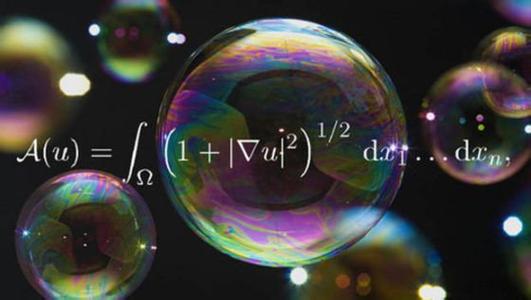
当前课程知识点:微积分-1 > Chapter 5 Integrals 积分(second part) > Unit 7 Areas and Volumes(面积与体积) > Areas and Volumes(面积与体积)
同学们 你们好
欢迎来到mooc在线课程微积分
现在呢 我们已经掌握了积分的
思想 理论和方法
并且上节课我们学习了
定积分的重要应用之一
就是求曲线的弧长
在这节课呢 我们继续学习
积分的重要应用
就是计算面积和体积
面积和体积呢
同学们再熟悉不过了
但是呢 对于比较复杂的形状
求面积和体积是不容易的
现在我们就要用积分这个工具
来计算一些特殊的形状的
面积和体积
好的 下面我们先从积分
与面积的关系谈起
Chapter 5 Integrals 积分
Unit 7 Areas and Volumes
面积与体积
Section One Area 面积
同学们上一单元我们已经
学会了怎么求弧长了 arc length
现在我们考虑一下怎么求面积
我们首先要明白一个道理
积分本身就代表了面积
integration can be thought of as
measuring the area under a curve
defined by f(x) between two points
什么意思呢
这就是我们前面解释过的
f的定积分就表示f从a到b
这两点之间扫过的面积
根据这个定积分的几何解释
下面我们讲这样一个问题
我们现在有两条曲线
现在如图中所示
一条是蓝色的一条是红色的
这两条曲线之间
所夹的部分的面积
该怎么算呢
那很简单只要做
两个积分的差就可以了
so this figure tells us
the area between two graphs
can be evaluated by calculating
the difference between the
integrals of the two functions
两个函数的积分值之差
就表示这上下两条不同的曲线
所夹的部分的面积 好的
我们把刚才的思想再总结一下
let f and g be continuous functions
whose graphs intersect at the
graphical points corresponding
to x equals a and x equals b
假设f和g是两个连续的函数
他们的图像与两条直线相交
谁呢 x等于a x等于b
其中a小于b
if g of x is less than or equals to
f of x on a to b then the area
bounded by f(x) and g(x) is A
equals integration f(x) minus g(x) dx
也就是说如果g是下面的曲线
f是上面的曲线
它们夹在x等于a与x等于b
之间的面积就是
f与g的差做定积分
我们来看一个简单的例子
evaluate the shaded area bounded by
f(x) equals x square and g(x)
equals x where x
is in between zero and one
现在我们这幅图
就表示了两条曲线
我们一定要小心
每次遇到这种问题
一定要小心谁是上面的曲线
谁是下面的曲线
否则我们减出来的值
不一定是正数了
在这一段区间从0到1之中呢
y等于x它是上面的曲线
而f(x)等于x的平方
它所对应的是下面这条曲线
它们之间所夹的面积
是图中黄色部分的面积
so we want to find the shaded area
阴影部分面积shaded area
应用刚才的公式
我们计算一下area A
equals integration
注意这里头两个函数
谁在前谁在后
x是上面的曲线所以它在前面
x的平方是下面的曲线
所以它在后面
它俩的差做定积分
这个结果很容易算出来
就是六分之一
于是我们计算出来了
刚才的阴影部分面积是六分之一
同学们要注意这段面积
只有通过积分的方法才能算出来
在中学阶段用任何初等的方法
都是无法计算的
同学们刚才我们讲了简单图形
求面积的方法
就是做函数差的积分
有的时候问题比较复杂
这个面积图形不能
直接应用刚才的公式
那个时候需要用转化的思想
转化成刚才这种情况的积分
限于时间关系我们这里
就不举比较复杂的例子了
课后习题中会出现这种问题
同学们自己要
动手动脑去做一下
接下来我们讲一下体积
一种特殊的体积就是
旋转体体积的求法
Section Two Volumes of Revolution
旋转体的体积
这里我们要考虑两种情况下
所产生的旋转体的体积
其中一种情况
我们要用一种方法去计算它
这种方法叫碟法 disk method
好的 我们简介一下disk method
disk method is a means of calculating
the volume of a solid of revolution
of a solid-state material when
integrating along the axis of revolution
什么意思呢 碟法顾名思义
就是用类似于碟子
这种形状的东西去叠加起来
求旋转体的体积
那么它所适用的是这种图形
就是某一个solid-state material
一个固定的固体
它是一个平面体
让它绕着某一个轴做旋转
this method models the resulting
three-dimensional shape as a stack of
an infinite number of disk of varying
radius and infinitesimal thickness
什么意思呢 意思就是说
这种方法它的思想是把
一大堆的碟子给叠起来
stack这里的意思是堆起来的意思
而每一个碟子
它的半径是不一样的
它的宽度也就是它的厚度
是非常非常薄的
我们用个图来表示一下
请看这幅图
这里呢 我们画了一条曲线
x equals f(y)
注意我们把x看成y的函数
然后让这条曲线和y轴之间
所夹的那一块面积
我们现在图中就是
划了横条的部分
让它绕着y轴旋转
这个旋转过程
就产生了一个旋转体
好了 我们在刚才这个
划着横线的部分我们把它
想象成很多的小条
每一个小条所扫过的图形
就是一个小碟子
把这些小碟子叠加起来
就会得到整体的体积
这就是碟法的思想
我们现在把它总结一下
disk method
assume that x equals f(y) is a
continuous function from c to d
现在假设x等于f(y)是一个函数
这个函数注意它自变量是y
从c到d是连续函数
and f(y) is always positive
then the volume of the solid of
revolution obtained by revolving
the region between the graph of f(y)
on [c,d] and rotate about y-axis is
什么意思呢
就是说我们现在要求一个
旋转体的体积了
这个旋转体是怎么来的呢
就是把x等于f(y)的曲线
注意这段曲线是从c到d跑的
它和y轴之间所夹的
那一部分面积
围绕着y轴取旋转一周
得到的旋转体
好这个旋转体的体积
就是底下这个公式
V equals pi the integration
from c to d f(y) square dy
这个公式的来由就是
我们刚才这幅图所展示的思想
也就是说把曲线x equals f(y)
给它划分成很多小段
每一段对应着一段长条
让这段长条绕着y轴旋转
得到很多很多的小碟子
把这些小碟子叠加起来
然后再取极限
这个过程我们就不详细解释了
同学们只要记住这样的公式
并理解它背后的思想就可以了
好了这种碟法讲的是x等于f(y)
绕着y轴旋转产生的固体的体积
那么类似的绕x轴呢
那么就有完全平行的一个方法
也叫碟法
assume that y equals f of x is continuous
over a to b and f(x) is always positive
then the volume of the solid of
revolution obtained by revolving
the region between the graph of
f(x) on a b about the x-axis is
such a formula
V equals pi times integration
from a to b f(x) square dx
这里这个定理跟刚才的定理的差异
就是我们考虑的曲线是
y等于f(x) y是x的函数
让这个曲线绕着x轴旋转
这里边x和y的位置颠倒了
所以这个公式是
和刚才这个公式相仿的
只是其中的x要替换成y
c d 换成a b 而已
这个思想是完全一致的
好的 我们看一个具体的例子
a solid cone is generated by revolving
the graph of y equals kx
y等于kx这个特别简单的曲线
它是直线其中k是大于0的
好了让x从0跑到b
这个时候我们考虑旋转体
让这个旋转体怎么产生呢
是y等于kx绕着x轴旋转一周
its volume is how much
我们直接用刚才的公式
来计算一下
就是pi乘以从0到b的积分
积分的函数就是那个函数的平方
就是kx的平方
well it’s easily seen result is
pi times a third of k square b cubed
这个公式同学们看到
可能觉得很熟悉
实际上它就是椎体的体积公式
好了我们用图来解释一下
图中我们画出的就是y equals kx
这个函数的图像
绕着x轴旋转一周所产生的圆锥
它的体积
同学们我们在小学的时候
就知道怎么算了
刚才这个公式也和我们小学时候
这个公式是完全一致的
接下来我们看
第二种产生旋转体的情形
这种情形
我们用的求解体积的方法
叫做壳法 shell method
好的我们解释一下 shell method
is a means of calculating the volume
of a solid of revolution when integrating
along an axis perpendicular to
the axis of revolution
这段话解释了shell method
壳法与前面的碟法的差异
这个壳法做积分的时候
是沿着旋转轴垂直的某个方向
而不是直接沿着旋转轴
我们用一幅图来解释壳法
shell method
现在这幅图中我们画的是
y equals f of x
就是y等于f(x)的曲线
它与x轴之间所夹的那部分
也就是我们划竖线的
那一部分面积
绕y轴旋转一周
产生了一个旋转体
现在我们要求这个旋转体的体积
怎么做呢 如图所示
图中我们把那个划着竖线的部分
想象成很多小块
每一块是一段小条
这个小条绕y轴一周
产生的是一个壳状的东西
因此把这些小的圆筒状的壳体
给它加起来
这个方法就叫做shell method
好的 我们继续把它实现一下
请看shell method
suppose that f is continuous
on a to b and a is positive and
f(x) is always positive or zero
let R be the plane region bounded by
f(x) x equals a x equals b and the
x-axis
也就是说假设R是这样的区域
它是f(x)的图像
x等于a x等于b
以及x轴这四者所夹的部分
the volume obtained by rotating R
around the y –axis is
下面就是壳法给出的公式
V equals the integration from a to b
two pi x times f(x) dx
注意这个公式跟刚才碟法的公式
是完全不一样的
这个原因我们这里
就不详细解释了
同学们自己可以思考一下为什么
这个思想还是刚才
我们这幅图中所解释的
就是求出每一个小的圆筒的体积
当然每一个小圆筒是有它的厚度
然后把这些小圆筒加起来
这个过程最后得到公式
就是现在所给的公式
好的我们看一个具体的例子
依然考虑刚才考虑过的那个函数
y equals kx where k is positive
and x is in between zero and b
让这个图像绕着y轴旋转
注意这个差异在这
刚才我们让这个直线
绕x轴旋转
现在是让这个直线
绕着y轴旋转
而且这个区域是y等于kx
与x轴之间还有x等于b
所夹的那一部分
绕y轴旋转产生的体积
同学们在纸上
最好先画一下这个图形
待会我们也给同学们一起画一下
好的这个时候呢
the volume of the revolution
obtained is how much
好的我们直接用刚才壳法的公式
就是 two pi the integration from
zero to b x times f of x
也就是kx
这个结果直接算出来就是
2 pi k乘以三分之一b的三次方
现在我们用图像来解释一下
请看这里我们画的就是
这个直线以及它与x轴以及
x等于b 这么三条线段
所夹的那个三角形
绕着y轴旋转一周
所产生的这样一个体
这个体并不是圆锥体
而是圆柱体去掉一个圆锥体
它的体积就是我们刚才
算出来的那个公式
同学们 这节课中 我们学习了
加在两条曲线之间的面积的求法
以及两种特殊情况的旋转体
和它们的体积公式
希望同学们能够牢记这些公式
并且能够区分这两种不同的旋转体
如果同学们学有余力的话
不妨自己在课后呢推导一下
这两种旋转体的公式
这样能够加深对这些公式的理解
好的同学们 讲完这一章
我们整个微积分的课程
也到此结束了
我们回顾一下
我们学过五个章节
包括实数理论 数列极限
函数极限与连续性
导数与微分 积分
这些知识呢
构成了整个微积分大厦的最基础部分
所以呢 我要感谢各位同学
自始至终的坚持与努力
将来呢 我们还要一起学习
更多的数学知识
我们的mooc在线课程微积分
是整个高等数学系列课程的一部分
将来呢 我们还有更多的课程
需要建设与完善
期待各位同学
在将来和我们一起同行
最后 祝愿同学们不断进步
同学们 再会
-Unit 1 Review of Real Numbers (回顾实数)
--Review of Real Numbers (回顾实数)
--Exercise1-1
-Unit 2 Exponentiations, Logarithms and Sets (指数、对数与集合)
--Exponentiations, Logarithms and Sets (指数、对数与集合)
--Exercise 1-2
-Unit 3 Limit Points, Open and Closed Sets (聚点、开集与闭集)
--Limit Points, Open and Closed Sets (聚点、开集与闭集)
--Exercise-1-3
-Unit 4 Bounds and Completeness (有界性与完备性)
--Bounds and Completeness (有界性与完备性)
--Exercises-1-4
-Unit 5 Complex Number System, Algebraic and Transcendental Numbers (复数、代数数与超越数)
--Complex Number System, Algebraic and Transcendental Numbers (复数、代数数与超越数)
--Exercise-1-5
-章节测验1
--章节测试1
-Unit 1 Limit of a Sequence (数列的极限)
--Exercises-2-1
-Unit 2 Theorems on Limits of Sequences (数列极限定理)
--Theorems on Limits of Sequences (数列极限定理)
--Exercises-2-2
-Unit 3 Infinity and Bounded Monotone Sequences (无穷大和单调有界数列)
--Infinity and Bounded Monotone Sequences (无穷大和单调有界数列)
--Exercises-2-3
-Unit 4 Limit Superior and Limit Inferior (上极限和下极限)
--Limit Superior and Limit Inferior (上极限和下极限)
--Exercises-2-4
-Unit 5 Nested Intervals Theorem and Cauchy’s Convergence Criterion (区间套定理和柯西收敛准则)
--Nested Intervals Theorem and Cauchy’s Convergence Criterion (区间套定理和柯西收敛准则)
--Exercises-2-5
-章节测验2
--章节测试2
-Unit 1 Functions and Graphs (函数与图像)
--Functions and Graphs (函数与图像)
--Exercises-3-1
-Unit 2 Algebraic Function,Transcendental Functions and Inverse Trigonometric Functions (代数函数,超越函数与反三
-- Algebraic Function,Transcendental Functions and Inverse Trigonometric Functions(代数函数,超越函数与反三角函数)
--Exercises-3-2
-Unit 3 Hyperbolic Functions and Inverse Hyperbolic Functions (双曲函数与反双曲函数)
--Hyperbolic Functions and Inverse Hyperbolic Functions(双曲函数与反双曲函数)
--Exercises-3-3
-Unit 4 Maximum and Minimum, Increasing and Decreasing (极大值与极小值,单调增与单调减)
--Maximum and Minimum, Increasing and Decreasing (极大值与极小值,单调增与单调减)
--Exercises-3-4
-Unit 5 Limits of Functions (函数的极限)
--Exercises-3-5
-Unit 6 Infinity (无穷)
--Exercises-3-6
-Unit 7 Theorems on Limits and Special Limits (极限相关定理与特殊极限)
--Theorems on Limits and Special Limits (极限相关定理与特殊极限)
--Exercises-3-7
-Unit 8 Continuities (连续性)
--Exercises-3-8
-Unit 9 Theorems on Continuity (关于连续性的定理)
--Theorems on Continuity (关于连续性的定理)
--Exercises-3-9
-Unit 10 Piecewise Continuity, Uniform Continuity, and Discontinuities (分段连续性, 一致连续性与不连续性)
--Piecewise Continuity, Uniform Continuity, and Discontinuities (分段连续性, 一致连续性与不连续性)
--Exercises-3-10
-Unit 11 Infinitesimals and Bounded Quantities (无穷小量与有界量)
--Infinitesimals and Bounded Quantities (无穷小量与有界量)
--Exercises-3-11
-章节测验3
--章节测试 3
-Unit 1 Basics of Derivatives (导数基本定义)
--Basics of Derivatives (导数的基本定义)
--Exercise-4-1
-Unit 2 Differentiability on Intervals, Piecewise Differentiability and Differentials (区间上的可微性,逐段可微性与
--Differentiability on Intervals, Piecewise Differentiability and Differentials (区间上的可微性,逐段可微性与微分)
--Exercise-4-2
-Unit 3 Basic Methods of Differentiation (基本求导方法)
--Basic Methods of Differentiation (基本求导方法)
--Exercise-4-3
-Unit 4 Derivatives of Commonly Used Functions (常见函数求导)
--Derivatives of Commonly Used Functions (常见函数求导)
--Exercise-4-4
-Unit 5 Higher Order Derivatives and Mean Value Theorem (高阶导数与中值定理)
--Higher Order Derivatives and Mean Value Theorem (高阶导数与中值定理)
--Exercise-4-5
-Unit 6 L'Hospital's Rules (洛必达法则)
--Exercise-4-6
-Unit 7 The First and Second Derivative Tests (导数判别法)
--The First and Second Derivative Tests (导数判别法)
-Unit 8 The Taylor Formula (泰勒公式)
--Exercise-4-8
-章节测验 4
--章节测试4
-Unit 1 Definite Integrals and Numerical Methods (定积分与数值方法)
-- Definite Integrals and Numerical Methods (定积分与数值方法)
- Exercise 5-1
-Unit 2 Properties of the Definite Integrals and the Fundamental Theorem of Calculus (定积分的性质与微积分基本定理)
--Properties of the Definite Integrals and the Fundamental Theorem of Calculus (定积分的性质与微积分基本定理)
--Exercise-5-2
-Unit 3 Integrals of Elementary Functions and Integration by Substitution (初等函数的积分,换元法)
--Integrals of Elementary Functions and Integration by Substitution (初等函数的积分,换元法)
--Exercise-5-3
-Unit 4 Integration by Parts and Special Techniques(分部积分法与特殊技巧)
--Integration by Parts and Special Techniques(分部积分法与特殊技巧)
--Exercise-5-4
-Unit 5 Integrations of Rational Fractions and Trigonometrical Rational Functions(有理分式函数与三角有理函数的积分)
-- Integrations of Rational Fractions and Trigonometrical Rational Functions(有理分式函数与三角有理函数的积分)
--Exercise-5-5
-Unit 6 Arc Length(弧长)
--Exercise-5-6
-Unit 7 Areas and Volumes(面积与体积)
--Exercise-5-7
-章节测验5
--章节测试5
-课程讲义

